


Next: for the IBM-SP2
Up: Parallel Monte Carlo Eigenvalue
Previous: IBM-SP2 Parallel Computer
We have measured parallel speedups for three different algorithms. The first
and second algorithms calculate eigenvalues
using the source iteration technique and the fission matrix approach,
respectively. The third algorithm calculates  K using the correlated
sampling technique applied to the fission matrix approach of eigenvalue
calculation (two
K using the correlated
sampling technique applied to the fission matrix approach of eigenvalue
calculation (two  Ks are calculated from a single Monte Carlo simulation).
The amount of
communication (measured within the master processor)
between the master and the slave processors is largest for the
perturbation algorithm and smallest for the source iteration eigenvalue
algorithm. The number of communications required per iteration for
the source iteration
algorithm is three, for the fission matrix algorithm is four,
and for the reactivity algorithm is eight.
Table 5.5 shows the constants a and b for the three algorithms.
In tables 5.6, 5.7, 5.8 and 5.9 we show wall-clock timing results for different
cases (i.e., number of particles/batch (p/b) and number of batches (b)) on the IBM-SP2
for the three different algorithms.
Figures 5.6 and 5.7 show observed and predicted speedup results for the source
iteration eigenvalue calculation. Figure 5.8 shows the percentage of
total computation time spent in communication (message passing) in the master
processor for the source iteration algorithm. Figures 5.9,
5.10, and 5.11 show similar plots for fission matrix eigenvalue calculations and
figures 5.12,
5.13 and 5.14 show plots for correlated sampling perturbation calculations. We
find that our predicted speedup results match the observed results reasonably
well. The observed results were taken on the dedicated IBM-SP2 parallel computer.
From the speedup plots, we see that we obtain speedups close to 9 for 10
processors for all the three algorithms. Among these three
algorithms, the perturbation algorithm shows largest fraction of total computation time
spent in communication.
Ks are calculated from a single Monte Carlo simulation).
The amount of
communication (measured within the master processor)
between the master and the slave processors is largest for the
perturbation algorithm and smallest for the source iteration eigenvalue
algorithm. The number of communications required per iteration for
the source iteration
algorithm is three, for the fission matrix algorithm is four,
and for the reactivity algorithm is eight.
Table 5.5 shows the constants a and b for the three algorithms.
In tables 5.6, 5.7, 5.8 and 5.9 we show wall-clock timing results for different
cases (i.e., number of particles/batch (p/b) and number of batches (b)) on the IBM-SP2
for the three different algorithms.
Figures 5.6 and 5.7 show observed and predicted speedup results for the source
iteration eigenvalue calculation. Figure 5.8 shows the percentage of
total computation time spent in communication (message passing) in the master
processor for the source iteration algorithm. Figures 5.9,
5.10, and 5.11 show similar plots for fission matrix eigenvalue calculations and
figures 5.12,
5.13 and 5.14 show plots for correlated sampling perturbation calculations. We
find that our predicted speedup results match the observed results reasonably
well. The observed results were taken on the dedicated IBM-SP2 parallel computer.
From the speedup plots, we see that we obtain speedups close to 9 for 10
processors for all the three algorithms. Among these three
algorithms, the perturbation algorithm shows largest fraction of total computation time
spent in communication.
Table:
Constants a and b of single processor execution time.
| 1|c|Algorithm type |
1|c| a (sec) |
1c| b (sec/history) |
| Source Iteration Eigenvalue |
0.5194 |
4.5692E-4 |
| Fission Matrix Eigenvalue |
0.02 |
4.434E-4 |
| Correlated Sampling Reactivity |
0.7431 |
6.5815E-4 |
Table:
Wall-clock Timing Results on IBM-SP2 for 8000 particle/batch, 100
batch case.
| # of |
3|c|Wall-clock timings in seconds |
|
|
| 1|c| processors |
1|c|Source Iteration |
1|c|Fission Matrix |
1c|Correlated Sampling |
| 1 |
365.84 |
357.52 |
527.59 |
| 2 |
212.23 |
183.96 |
279.25 |
| 4 |
105.24 |
100.11 |
158.92 |
| 8 |
58.72 |
59.51 |
97.61 |
| 10 |
50.73 |
56.39 |
81.55 |
Table:
Wall-clock Timing Results on IBM-SP2 for 16000 particle/batch, 100
batch case.
| # of |
3|c|Wall-clock timings in seconds |
|
|
| 1|c|processors |
1|c|Source Iteration |
1|c|Fission Matrix |
1c|Correlated Sampling |
| 1 |
731.73 |
710.94 |
1053.57 |
| 2 |
377.43 |
369.10 |
590.04 |
| 4 |
200.64 |
190.38 |
280.29 |
| 8 |
107.58 |
107.40 |
166.28 |
| 10 |
98.18 |
89.30 |
151.37 |
Table:
Wall-clock Timing Results on IBM-SP2 for 16000 particle/batch, 50
batch case.
| # of |
3|c|Wall-clock timings in seconds |
|
|
| 1|c|processors |
1|c|Source Iteration |
1|c|Fission Matrix |
1c|Correlated Sampling |
| 1 |
364.36 |
354.04 |
526.03 |
| 2 |
187.65 |
195.72 |
277.08 |
| 4 |
98.82 |
98.59 |
141.53 |
| 8 |
53.78 |
50.44 |
78.39 |
| 10 |
45.47 |
44.10 |
70.20 |
Table:
Wall-clock Timing Results on IBM-SP2 for 32000 particle/batch, 50
batch case.
| # of |
3|c|Wall-clock timings in seconds |
|
|
| 1|c|processors |
1|c|Source Iteration |
1|c|Fission Matrix |
1c|Correlated Sampling |
| 1 |
729.08 |
709.55 |
1050.06 |
| 2 |
372.50 |
361.28 |
550.08 |
| 4 |
192.92 |
191.80 |
284.25 |
| 8 |
104.75 |
97.13 |
158.12 |
| 10 |
84.29 |
82.02 |
123.57 |
Figure:
Source Iteration Speedup Plots.
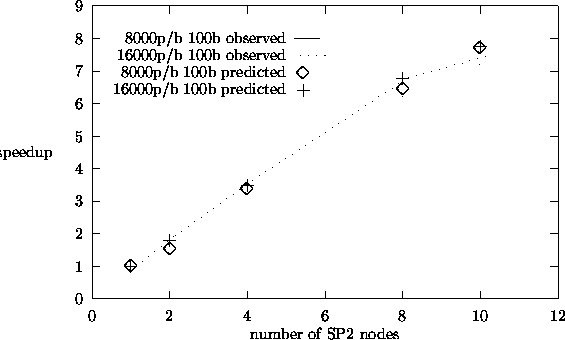 |
Figure:
Source Iteration Speedup Plots.
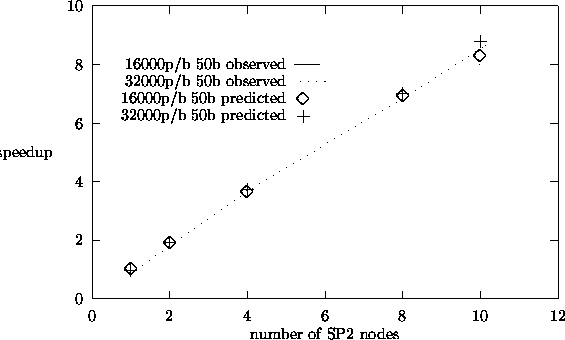 |
Figure:
% of Total Time Spent in Communication in a Processor for Source Iteration.
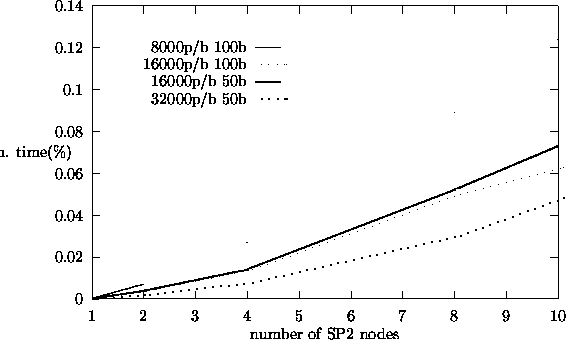 |
Figure:
Fission Matrix Speedup Plots.
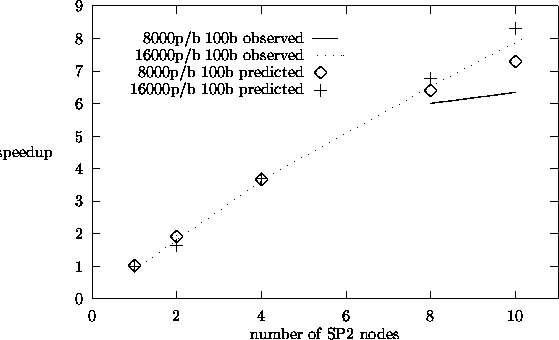 |
Figure:
Fission Matrix Speedup Plots.
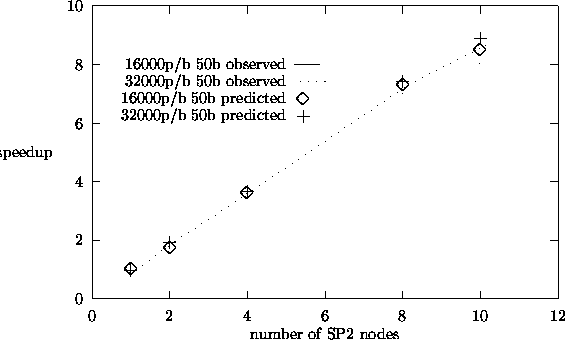 |
Figure:
% of Total Time Spent in Communication in a Processor for Fission Matrix.
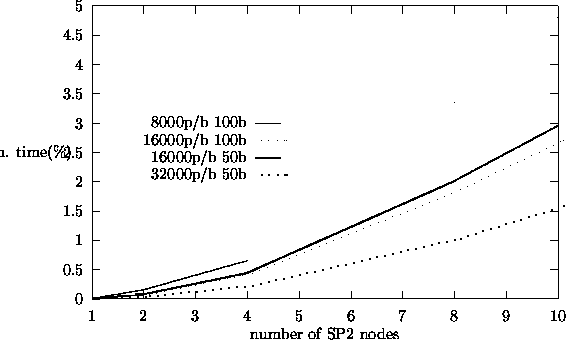 |
Figure:
Correlated Sampling Speedup Plots.
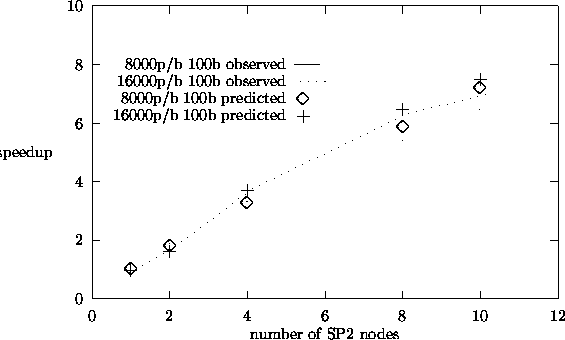 |
Figure:
Correlated Sampling Speedup Plots.
 |
Figure:
% of Total Time Spent in Communication in a Processor for Correlated Sampling.
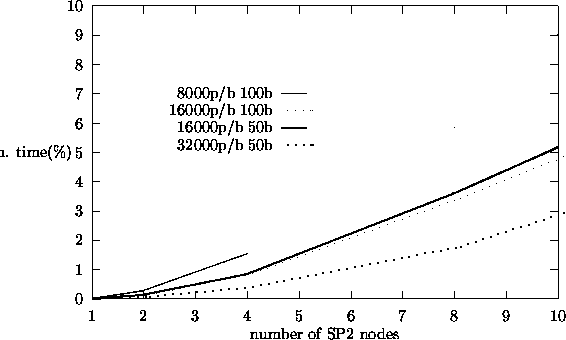 |



Next: for the IBM-SP2
Up: Parallel Monte Carlo Eigenvalue
Previous: IBM-SP2 Parallel Computer
Amitava Majumdar
9/20/1999
![]() K using the correlated
sampling technique applied to the fission matrix approach of eigenvalue
calculation (two
K using the correlated
sampling technique applied to the fission matrix approach of eigenvalue
calculation (two ![]() Ks are calculated from a single Monte Carlo simulation).
The amount of
communication (measured within the master processor)
between the master and the slave processors is largest for the
perturbation algorithm and smallest for the source iteration eigenvalue
algorithm. The number of communications required per iteration for
the source iteration
algorithm is three, for the fission matrix algorithm is four,
and for the reactivity algorithm is eight.
Table 5.5 shows the constants a and b for the three algorithms.
In tables 5.6, 5.7, 5.8 and 5.9 we show wall-clock timing results for different
cases (i.e., number of particles/batch (p/b) and number of batches (b)) on the IBM-SP2
for the three different algorithms.
Figures 5.6 and 5.7 show observed and predicted speedup results for the source
iteration eigenvalue calculation. Figure 5.8 shows the percentage of
total computation time spent in communication (message passing) in the master
processor for the source iteration algorithm. Figures 5.9,
5.10, and 5.11 show similar plots for fission matrix eigenvalue calculations and
figures 5.12,
5.13 and 5.14 show plots for correlated sampling perturbation calculations. We
find that our predicted speedup results match the observed results reasonably
well. The observed results were taken on the dedicated IBM-SP2 parallel computer.
From the speedup plots, we see that we obtain speedups close to 9 for 10
processors for all the three algorithms. Among these three
algorithms, the perturbation algorithm shows largest fraction of total computation time
spent in communication.
Ks are calculated from a single Monte Carlo simulation).
The amount of
communication (measured within the master processor)
between the master and the slave processors is largest for the
perturbation algorithm and smallest for the source iteration eigenvalue
algorithm. The number of communications required per iteration for
the source iteration
algorithm is three, for the fission matrix algorithm is four,
and for the reactivity algorithm is eight.
Table 5.5 shows the constants a and b for the three algorithms.
In tables 5.6, 5.7, 5.8 and 5.9 we show wall-clock timing results for different
cases (i.e., number of particles/batch (p/b) and number of batches (b)) on the IBM-SP2
for the three different algorithms.
Figures 5.6 and 5.7 show observed and predicted speedup results for the source
iteration eigenvalue calculation. Figure 5.8 shows the percentage of
total computation time spent in communication (message passing) in the master
processor for the source iteration algorithm. Figures 5.9,
5.10, and 5.11 show similar plots for fission matrix eigenvalue calculations and
figures 5.12,
5.13 and 5.14 show plots for correlated sampling perturbation calculations. We
find that our predicted speedup results match the observed results reasonably
well. The observed results were taken on the dedicated IBM-SP2 parallel computer.
From the speedup plots, we see that we obtain speedups close to 9 for 10
processors for all the three algorithms. Among these three
algorithms, the perturbation algorithm shows largest fraction of total computation time
spent in communication.